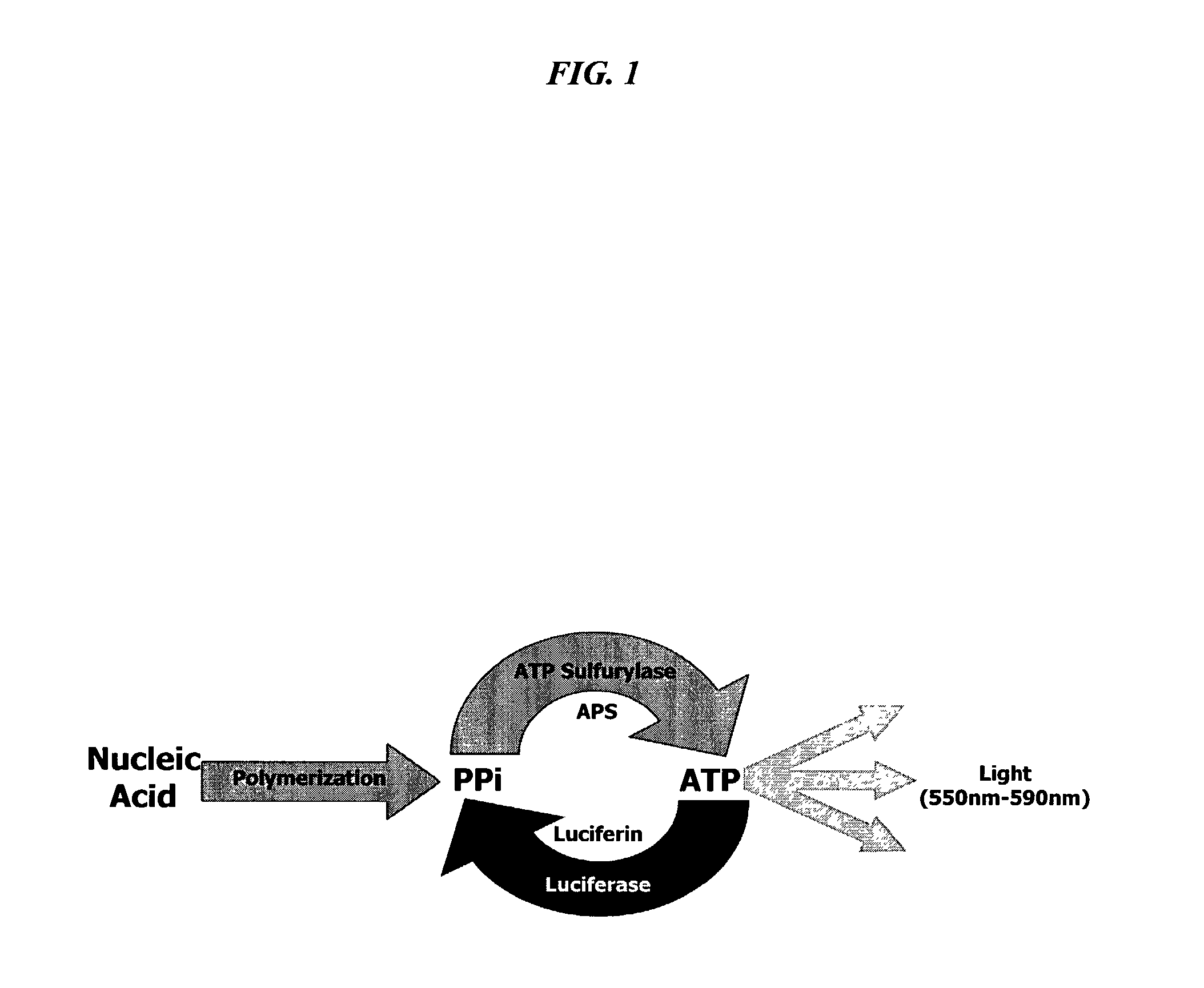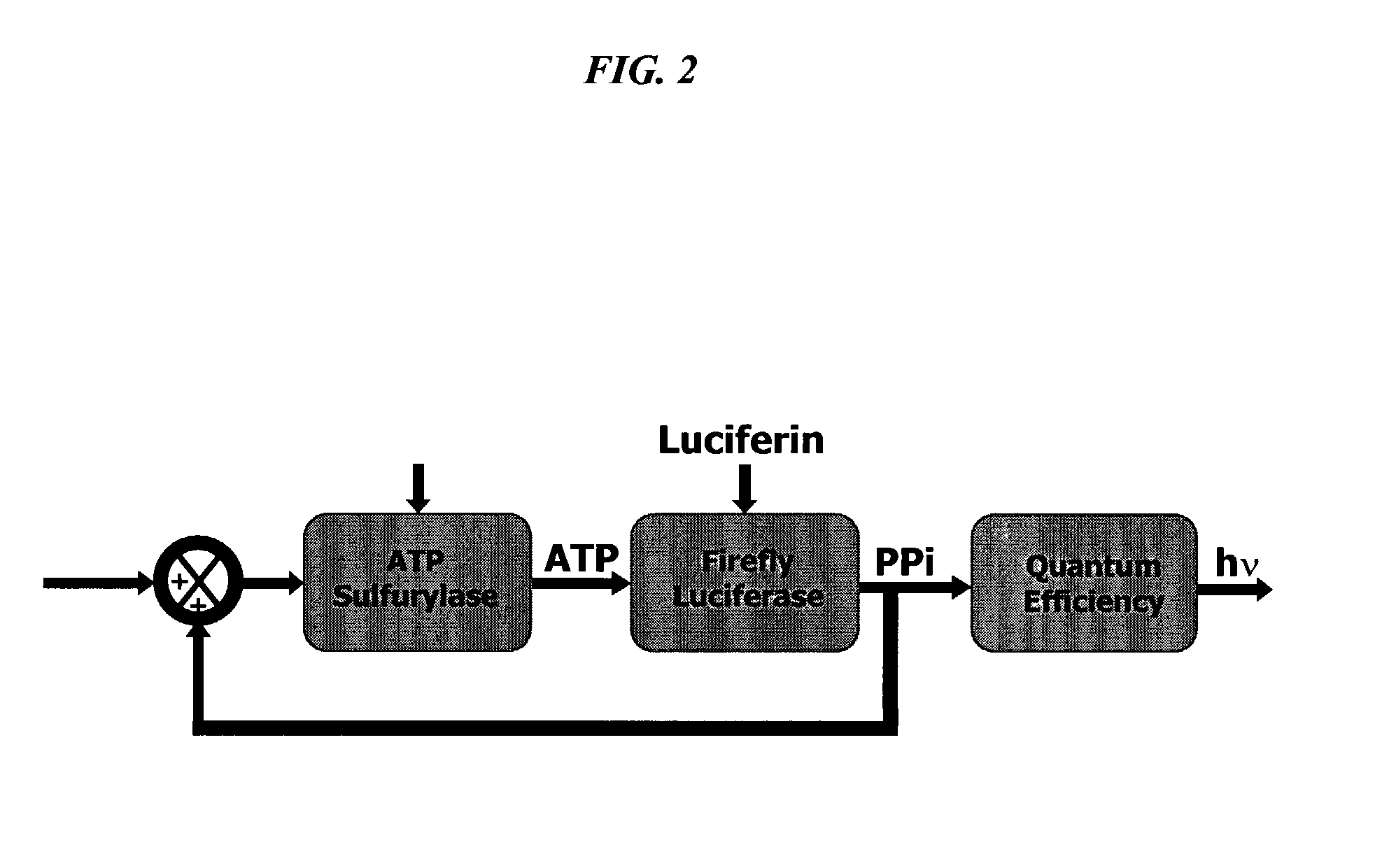Bioluminescence regenerative cycle (BRC) for nucleic acid quantification
- Summary
- Abstract
- Description
- Claims
- Application Information
AI Technical Summary
Benefits of technology
Problems solved by technology
Method used
Image
Examples
example 1
BRC Assay
[0088]Sample Preparation
[0089]Total RNA extracts may be obtained from blood, tissues or cell lines using commercially available kits (e.g., Ambion, Austin, Tex.; Qiagen, Valencia, Calif.; Promega, Madison, Wis.). CDNA may be synthesized using a SuperScript™ or other commercial kit (Invitrogen Life Technologies, Austin, Tex.). Where preferred, polyadenylated mRNA may be purified by oligo(dT) column chromatography or other known methods.
[0090]In an exemplary embodiment, first strand cDNA synthesis employed an RNA / primer mixture containing 5 μl total RNA and 1 μl of 0.5 μg / μl oligo(dT) random primer or gene specific primer, incubated at 70° C. for 10 min and then placed on ice for at least 1 min. A reaction mixture containing 2 μl 10× buffer (0.1 M Tris-Acetate pH 7.75, 5 mM EDTA, 50 mM Mg-acetate, 2 mM kinase free dNTP and 0.1 M dithiothreitol) in which dATP was replaced with (α-thio dATP was added to the RNA / primer mixture, mixed gently, collected by brief centrifugation and...
example 2
SNP detection Using Total RNA Templates
[0104]SNPs have been detected by hybridization of total RNA incubated with gene specific or allele specific primers and / or probes (Higgins et al, Biotechniques 23:710–714, 1997; Newton et al. Lancet 2:1481–1483, 1989; Goergen et al, J Med Virol 43:97–102, 1994; Newton et al, Nucleic Acids Res 17:2503–2516, 1989). Using the methods disclosed herein, SNPs may be detected by BRC, using sequence specific extension primers designed to bind to the template with the 3′ end of the primer located over the base of interest (SNP site) (FIG. 7). In preferred embodiments, the primer sequence is selected so that the end of the primer to which nucleotides will be attached is base-paired with the polymorphic site. In certain embodiments, where the SNP is located in a coding sequence, the primer may be allowed to hybridize to total RNA or polyadenylated mRNA. (Alternatively, to detect non-coding SNPs genomic DNA or PCR amplified genomic DNA may be used as the t...
example 3
SNP Detection Using cDNA Templates
[0106]In alternative embodiments, SNPs may be detected from cDNA templates. Complementary DNAs may be prepared by standard methods, as disclosed above, and hybridized with gene specific or allele specific primers (FIG. 7) in 20 mM Tris-HCl (pH 7.5), 8 mM MgCl2 or other standard conditions. The primers are designed to bind to the template with the 3′ end located over the polymorphic position. The template / primer fragments are then used as substrates in a primer extension reaction, as discussed above. Pyrophosphate generation, detected by the BRC reaction, indicates the presence of a SNP sequence that is complementary to the primer. As discussed above, gene specific primers also may be used in combination with single dXTPs.
PUM
| Property | Measurement | Unit |
|---|---|---|
| Substance count | aaaaa | aaaaa |
| Substance count | aaaaa | aaaaa |
Abstract
Description
Claims
Application Information
 Login to View More
Login to View More - R&D
- Intellectual Property
- Life Sciences
- Materials
- Tech Scout
- Unparalleled Data Quality
- Higher Quality Content
- 60% Fewer Hallucinations
Browse by: Latest US Patents, China's latest patents, Technical Efficacy Thesaurus, Application Domain, Technology Topic, Popular Technical Reports.
© 2025 PatSnap. All rights reserved.Legal|Privacy policy|Modern Slavery Act Transparency Statement|Sitemap|About US| Contact US: help@patsnap.com



